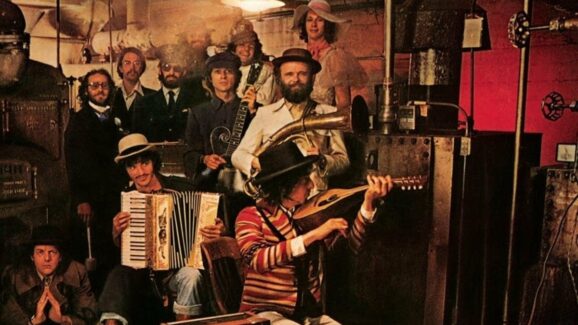With the booming clatter of Spencer Dryden’s drums at the very outset of Surrealistic Pillow, “She Has Funny Cars” announces the arrival of a new Jefferson Airplane. Yet the general public would not be aware of this change until months later when the two songs brought to the group by vocalist Grace Slick, “Somebody to Love” and “White Rabbit,” became across-the-board hit singles. The Airplane would thus come to represent the counter-cultural movement centered in San Francisco, at least to mainstream America, while the enlistment of these two new members would act as a catalyst for the band’s growth as an instrumental and vocal powerhouse.
Replacing drummer Skip Spence—who left to join Moby Grape in 1966–Dryden brought both jazz influences and power to his bonding with bassist Jack Casady and guitarist Jorma Kaukonen, thus facilitating their natural inclinations to improvise. And Slick contributed to that freewheeling ethos too, the dynamic strength(s) of her voice allowing her to belt out those aforementioned hits as well as sing counterpoint melodies and harmonies alongside founding member Marty Balin as well as guitarist/composer Paul Kantner.
Grace became the focal point of the group as she emigrated from a band that had the audacity to call itself ‘The Great Society”(and whose membership included then-husband Jerry on drums and his brother Darby on guitar). Joining the Airplane following the departure of its first distaff singer Signe Toly Anderson, the Finch College attendee and former model’s future originals, along with those of Kantner, would come to dominate subsequent albums of the group’s like After Bathing At Baxter’s, but on this sophomore JA outing, Balin is the major contributor (foreshadowing his significant re-enlistment for Jefferson Starship in 1975 at which time his temperate soulful tune“Miracles” became a hit from the LP Red Octopus).
Surrealistic Pillow (released 2/1/67) is thus the last album where Balin’s contributions dominate the artistic proceedings. And though the highlights here are overshadowed by the commercially popular numbers, the ballads, ”Comin’ Back to Me” and “Today” (a collaboration with Paul Kantner) are works of musical and lyrical poetry, rendered all the more stunning by the haunting (and haunted) soulful singing of Balin. Juxtaposed in the track sequencing, this pair of tracks stand out all the more from their surroundings, even the polite, sweet harmony-laden “My Best Friend” so reminiscent of the JA debut Takes Off.
Marty also pointed the way to a new direction for Jefferson Airplane even though a heavier rock approach somewhat contradicted his original, somewhat pop-slanted vision. Like the aforementioned raucous opening (not surprisingly co-written with Jorma), “3/5 of a Mile in 10 Seconds” and “Plastic Fantastic Lover” are tough rockers, appropriately wailed by their author as he offered observations on contemporary culture as scathing as the instrumental backing from Casady, Kaukonen, and Dryden. While the man’s natural high tenor voice would become almost unrecognizable in his attempts to rise above the trio’s driving din on subsequent live recordings, such as 1969’s concert album Bless Its Pointed Little Head, his presence aided in no small part to galvanize Jefferson Airplane’s expansive stage presence.
Its whimsical title courtesy of Jerry Garcia— the titular leader of the Grateful Dead is credited as ‘spiritual advisor’ for the record–Surrealistic Pillow became the first blockbuster psychedelic album by a band from San Francisco. Subsequent exposure of the Airplane’s counter-cultural stance(s) grew to be overtly political, a shift in which Marty Balin participated to some degree: he was Paul’s co-composer on “Volunteers” for their 1969 album of the same name.
But the growth in prominence of Kantner and Slick as songwriters in the studio and focal points on stage no doubt hastened his departure in 1970. By that time too, former guitar teacher Kaukonen’s contributions of material were more regular –though not all in the form of his acoustic guitar wizardry here by the name of “Embryonic Journey.” And his regression from the group otherwise became crucial when Airplane touring slowed: he formed Hot Tuna with bassist Jack Casady to keep playing regularly and often. None of these repercussions, of course, lessen the seismic impact of a record that hasn’t dated appreciably in the interim. On the contrary, with the discerning hindsight of a half-century, Surrealistic Pillow has become memorable for reasons other than the most obvious, its durability growing deservedly over the course of this protracted period of time.









